Colombaia is located in Colle Val d’Elsa, in the Siena province. The Lomazzi family has been involved in wine for generations, but today’s winery was only founded in the 1970’s, when they restored an old abandoned farm, and acquired a new one. Now they have 3 hectars of 40 year old plantings of Tuscan grapes, and another planted in 2005 – all biodynamically grown since 2003. There is as little intervention as possible. The wines are either treated in steel or old, big Slavonian oak vessels, and SO2 (if used at all) is only added in tiny quantities before bottling.
The soil is calcareous clay, rich in fossil shells. For this particular wine the grapes were hand-picked, spontaneously fermented, and the wine was kept for 18 months in the big, old vats. The grape composition is sangiovese and a small percentage of colorino. In some years it also contains canaiolo and the white malvasia.
Colombaia Rosso Toscano 2011 (Colombaia)
Ruby red. Aroma of mature red berries, some spice and mushroom. Concentrated, yet smooth, rounded, with a chalky minerality, and the good acidity contributes to a prolonged aftertaste. Peaking now.
Price: Medium
Leave a Comment












